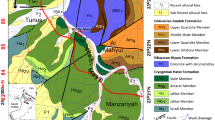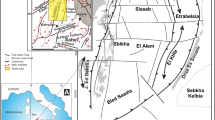Abstract
This paper describes seismic velocity tomography applied to the investigation and assessment of karst collapse hazards to facilitate accurate characterization of geological conditions of karst sinkhole formation. In the survey areas of **amao, Guangzhou, China, and Huangchi, Foshan, China, seismic velocity tomography was used to explore the structures of rock and soil associated with karst collapse. The results show that sand intercalated with clay or clay intercalated with soft soil dominates the cover of these two areas. The overburden is 20–33 m thick and underlain by Carboniferous limestone. In the limestone, there are well-developed karst caves and cracks as well as highly fluctuating bedrock surfaces. The seismic velocities are less than 2500 m/s in the cover, 2500–4500 m/s in the karst fracture zones and caves of **amao, and 1500–2000 m/s in the Huangchi collapse area. The karst fracture zones, relief of bedrock surfaces, and variations of soil thicknesses revealed by seismic velocity tomography are well constrained and in agreement with those in the drilling borehole profiles. This paper demonstrates that seismic velocity tomography can delineate anomalies of rock and soil with the advantages of speed, intuitive images, and high resolution.









Similar content being viewed by others
References
Angioni T, Rechtien RD, Cardimona SJ, Luna R (2003) Crosshole seismic tomography and borehole logging for engineering site characterization in Sikeston, MO, USA. Tectonophysics 368(1):119–137
Cardarelli E, Cercato M, Cerreto A, Di Filippo G (2010) Electrical resistivity and seismic refraction tomography to detect buried cavities. Geophys Prospect 58(4):685–695
Carpenter PJ, Higuera-Diaz IC, Thompson MD, Atre S, Mandell W (2003) Accuracy of seismic refraction tomography codes at karst sites. In: Symposium on the application of geophysics to engineering and environmental problems, pp 832–840
Cheng X, Huang RQ (2002) Geological conceptive models of karst collapse. Hydrogeol Eng Geol 29(6):30–34
Deceuster J, Delgranche J, Kaufmann O (2006) 2D cross-borehole resistivity tomographies below foundations as a tool to design proper remedial actions in covered karst. J Appl Geophys 60(1):68–86
Hiltunen DR, Cramer BJ (2008) application of seismic refraction tomography in karst terrane. J Geotechn Geoenviron Eng 134(7):938–948
Jackson PD, Gunn DA, Flint RC, McCann DM, Bent M, Howes D (2001) Cross-hole seismic measurements for detection of disturbed ground beneath existing structures. NDT&E Int 34(2):155–162
Lei MT, Jiang XZ (1998) Research on the present situation and develo** tendency of karst collapse and techniques for its supporting. Chin J Geol Hazard Control 9(3):1–6
Lei JS, Yang JS, **ao WQ, Liu CJ (2009) Analysis of forming conditions and main influential factors of karst collapse in Guanzhou. Geol Explor 45(4):488–492
Li HG, Xu YM, Guan FJ, Cui ZG (2011) Discussion on applications of seismic wave CT technology for survey pile location of some passenger dedicated line in karst area. Railway Investig Surv 37(1):61–64
Liu HG, Xu HG, Song WR (2003) Crosshole ultrasonic tomography and its application to karst investigation. Earthq Sci 16(4):441–448
Meng XB, Wang Y (2008) Application of CT technique for earthquake in investigation of karst along Ha’erbin-Dalian passenger dedicated line. Railway Investig Surv 34(6):56–60
Nath SK, Pani A, Sengupta S (1996) Forward modelling in cross-hole seismic tomography using reciprocity. Comput Struct 61(5):805–817
Park MK, Park S, Yi MJ, Kim C, Son JS, Kim JH, Abraham AA (2014) Application of electrical resistivity tomography (ERT) technique to detect underground cavities in a karst area of South Korea. Environ Earth Sci 71(6):2797–2806
Sagong M, Park CS, Lee B, Chun BS (2012) Cross-hole seismic technique for assessing in situ rock mass conditions around a tunnel. Int J Rock Mech Min Sci 53:86–93
Sheehan JR, Doll WE, Watson DB, Mandell WA (2005) Application of seismic refraction tomography to karst cavities. US Geological Survey Karst Interest Group Proceedings, Rapid City, South Dakota, pp 29–38
Šumanovac F, Weisser M (2001) Evaluation of resistivity and seismic methods for hydrogeological map** in karst terrains. J Appl Geophys 47(1):13–28
Zong N, Fu KL, Ma JJ (2007) The main problems and counter measure of karst in enlarge capacity engineering on Guizhou–Guangxi railway. Subgrade Eng 2:152–154
Author information
Authors and Affiliations
Corresponding author
Additional information
This article is a part of the Topical Collection in Environmental Earth Sciences on Karst Hydrogeology: Advances in Karst Collapse Studies, edited by Dr. Zhou Wanfang.
Rights and permissions
About this article
Cite this article
Zhao, W., Gan, F., Meng, Y. et al. Application of seismic velocity tomography in investigation of karst collapse hazards, Guangzhou, China. Environ Earth Sci 77, 258 (2018). https://doi.org/10.1007/s12665-018-7419-1
Received:
Accepted:
Published:
DOI: https://doi.org/10.1007/s12665-018-7419-1




